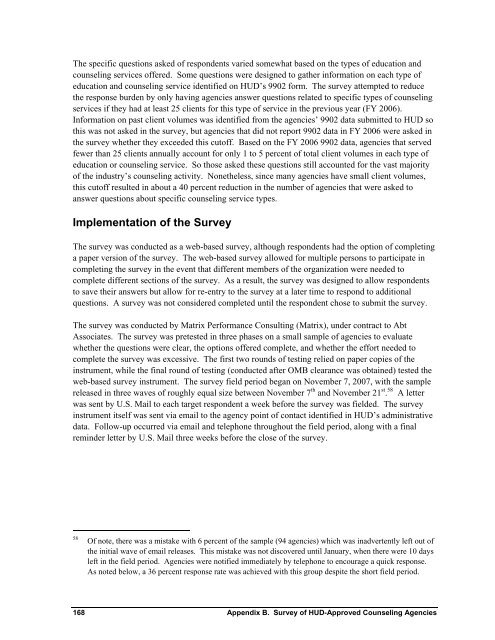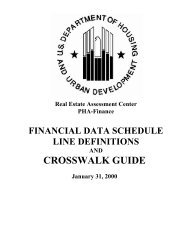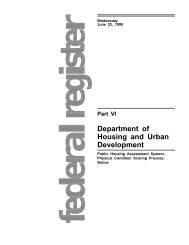Housing Counseling Process Evaluation and Design of ... - HUD User
Housing Counseling Process Evaluation and Design of ... - HUD User
Housing Counseling Process Evaluation and Design of ... - HUD User
Create successful ePaper yourself
Turn your PDF publications into a flip-book with our unique Google optimized e-Paper software.
The specific questions asked <strong>of</strong> respondents varied somewhat based on the types <strong>of</strong> education <strong>and</strong><br />
counseling services <strong>of</strong>fered. Some questions were designed to gather information on each type <strong>of</strong><br />
education <strong>and</strong> counseling service identified on <strong>HUD</strong>’s 9902 form. The survey attempted to reduce<br />
the response burden by only having agencies answer questions related to specific types <strong>of</strong> counseling<br />
services if they had at least 25 clients for this type <strong>of</strong> service in the previous year (FY 2006).<br />
Information on past client volumes was identified from the agencies’ 9902 data submitted to <strong>HUD</strong> so<br />
this was not asked in the survey, but agencies that did not report 9902 data in FY 2006 were asked in<br />
the survey whether they exceeded this cut<strong>of</strong>f. Based on the FY 2006 9902 data, agencies that served<br />
fewer than 25 clients annually account for only 1 to 5 percent <strong>of</strong> total client volumes in each type <strong>of</strong><br />
education or counseling service. So those asked these questions still accounted for the vast majority<br />
<strong>of</strong> the industry’s counseling activity. Nonetheless, since many agencies have small client volumes,<br />
this cut<strong>of</strong>f resulted in about a 40 percent reduction in the number <strong>of</strong> agencies that were asked to<br />
answer questions about specific counseling service types.<br />
Implementation <strong>of</strong> the Survey<br />
The survey was conducted as a web-based survey, although respondents had the option <strong>of</strong> completing<br />
a paper version <strong>of</strong> the survey. The web-based survey allowed for multiple persons to participate in<br />
completing the survey in the event that different members <strong>of</strong> the organization were needed to<br />
complete different sections <strong>of</strong> the survey. As a result, the survey was designed to allow respondents<br />
to save their answers but allow for re-entry to the survey at a later time to respond to additional<br />
questions. A survey was not considered completed until the respondent chose to submit the survey.<br />
The survey was conducted by Matrix Performance Consulting (Matrix), under contract to Abt<br />
Associates. The survey was pretested in three phases on a small sample <strong>of</strong> agencies to evaluate<br />
whether the questions were clear, the options <strong>of</strong>fered complete, <strong>and</strong> whether the effort needed to<br />
complete the survey was excessive. The first two rounds <strong>of</strong> testing relied on paper copies <strong>of</strong> the<br />
instrument, while the final round <strong>of</strong> testing (conducted after OMB clearance was obtained) tested the<br />
web-based survey instrument. The survey field period began on November 7, 2007, with the sample<br />
58<br />
released in three waves <strong>of</strong> roughly equal size between November 7 th <strong>and</strong> November 21 st . A letter<br />
was sent by U.S. Mail to each target respondent a week before the survey was fielded. The survey<br />
instrument itself was sent via email to the agency point <strong>of</strong> contact identified in <strong>HUD</strong>’s administrative<br />
data. Follow-up occurred via email <strong>and</strong> telephone throughout the field period, along with a final<br />
reminder letter by U.S. Mail three weeks before the close <strong>of</strong> the survey.<br />
58<br />
Of note, there was a mistake with 6 percent <strong>of</strong> the sample (94 agencies) which was inadvertently left out <strong>of</strong><br />
the initial wave <strong>of</strong> email releases. This mistake was not discovered until January, when there were 10 days<br />
left in the field period. Agencies were notified immediately by telephone to encourage a quick response.<br />
As noted below, a 36 percent response rate was achieved with this group despite the short field period.<br />
168<br />
Appendix B. Survey <strong>of</strong> <strong>HUD</strong>-Approved <strong>Counseling</strong> Agencies
















